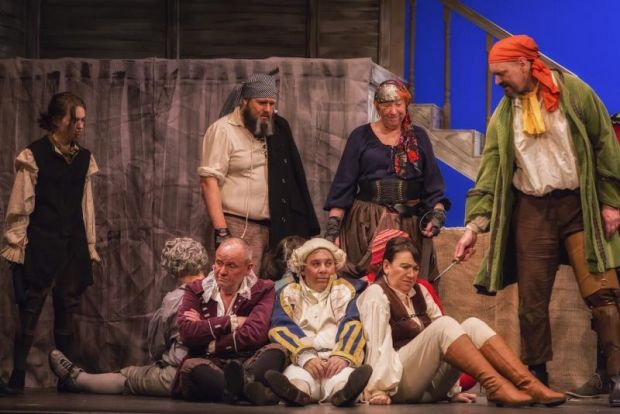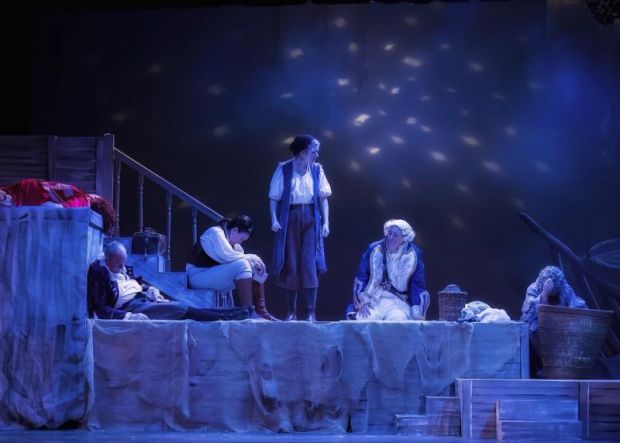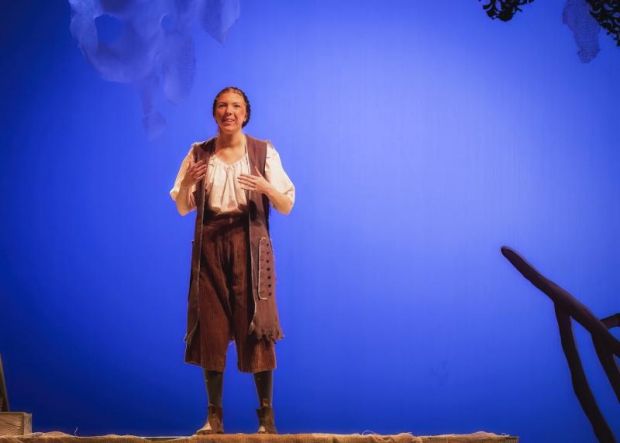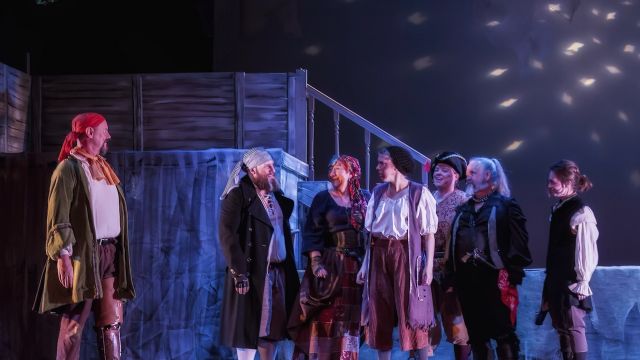Treasure Island
Robert Louis Stephenson’s Treasure Island has long been many people’s source of all things pirate: ‘X marks the spot’, one-legged bad guys, and shoulder-sitting parrots are archetypes first presented by Stephenson in his ‘boys own’ adventures. This production is brought to the Adelaide stage by The Rep and director Megan Dansie.
Playwright Bryony Lavery adapted the original story for Britain’s National Theatre, condensing its slow build-up into the first scene, and allowing a more accurate reflection of gender amongst eighteenth century pirates. Characters such as ‘Red Ruth’ and ‘Joan the Goat’ give the pirate gang some diversity, and Lavery’s decision to make Jim a young girl is often referenced in the dialogue, she’s deliberate in that not changing the character’s actions or motivations: ‘Be you boy or be you girl?’ asks a pirate; ‘That be my business,’ replies an indignant Jim, who proves that adventure is for everyone.

Sophie Livingston-Pearce carries the play from the very start, narrating the story as if from Stephenson’s pages. She captures the essence of a young adult engrossing themselves into adventure, the mixture of fear and excitement clear on her face. Her relationship with John Silver (Stuart Pearce) is believable: trusting at first, in awe of his stories, but later proudly bold and definitive against his amoral treachery. Livingston-Pearce shows the enormity of emotion and is fantastic in how she grows as Jim, from an innocent teenager to industrious and independent fighter.
However, Lavery has chosen to polish the swashbuckle with comedy, which doesn’t always work. There’s a darkness in the original story that rarely manifests in this adaptation. Stuart Pearce is wonderfully ambiguous as John Silver: charismatic at first, he draws in Jim – and the audience, despite already knowing he will be revealed as a villain. And when that happens, that charisma remains, which only makes him more sinister.
Other characters do not fare so well: Doctor Livesey, the moral compass in the novel, becomes a comedic caricature: Bronwyn Ruciak plays the character deadpan, which raises a smile, but doesn’t have to deal with the thorny issues that Stephenson wrote about, such as whether to give medical aid to the bad guys or leave them to die.

Similarly, Squire Trelawney, his upper class largely irrelevant in this genial country community, is well-meaning if not very diplomatic, but here is reduced to a costumed buffoon, unable to keep his mouth shut. Yet he’s been given more comedy to exaggerate, and Ben Todd delivers brilliantly, his facial expressions betraying his character’s thoughts even when he’s not centre-stage.
Thomas Midena gives tremendous depth to Israel Hands, a Spanish-speaking pirate, and Jenny Allan brings great comic pathos to her character, Grey, who is constantly forgotten by the remainder of the crew, despite being the turning point in the story on more than one occasion.
Maxwell Whigham steals the second act as Ben Gunn: marooned on the island for three years, his conversations with himself are as funny as they are sad, and Whigham has astounding physicality as he bounces around (and beneath) the staging, craving cheese.
Director Megan Dansie uses this ensemble cast well through this adaptation – there is clear definition of personality and purpose for each of them, and that’s a good achievement for this cast of mixed experience. However, the pacing can be inconsistent: despite the reduction from the original novel, act one still feels too long. Act two moves much more smoothly, and the scene transitions are good, helped by the small band of musicians who play and sing Phil Short’s shanties beautifully. Yet the ending feels rushed, and its conclusion unclear. So often in this play, knowledge of the original story fills in a gap, but the climax on the island is significantly different from its source.

Whilst challenging to get twenty cast on the stage simultaneously, some of their positioning doesn’t seem right – dialogue is lost when it happens behind other performers and with their backs to the audience. The large sword fighting with most of the cast is impressive, though there’s room for it to feel more dangerous.
The set is magnificent – designed by Bob Peet, its salt-bleached wood works for both the interiors of the Admiral Benbow pub and the sun-scorched island. Its many levels are multi-purpose, serving as the upstairs of the pub and the tunnels of the island without requiring huge changes.
Richard Parkhill’s lighting is better when it’s shadowed – especially on the deck of the Hispaniola, where you feel the enormity of being on a small ship in a great sea; Jay Antoney’s sound design enhances the environment; and Gillian Cordell’s costume design (with director Dansie) helps sustain the image that pirating was not a glamourous lifestyle!
And that’s part of where this production succeeds: where the romanticism of adventure is quickly pushed aside by dangerous reality; where a young idealist can triumph over old cynics; and where the loftiest ambition is for a decent cheese.
Mark Wickett
(Reviewer Mark Wickett spent his formative drinking years in Bristol’s Llandoger Trow, the inspiration for Stephenson’s Admiral Benbow hotel.)
Photographer: Richard Parkhill
Subscribe to our E-Newsletter, buy our latest print edition or find a Performing Arts book at Book Nook.

